
Jazz might not enjoy the spotlight as much as it did in the past, but it is no less popular. But who are the most popular jazz musicians according to the Baby Boomer generation? Well, according to a survey conducted by YouGov, we have the answer! If you are a Baby Boomer, then these are the artists your companions are listening to the most.
Why Are We Talking About This?
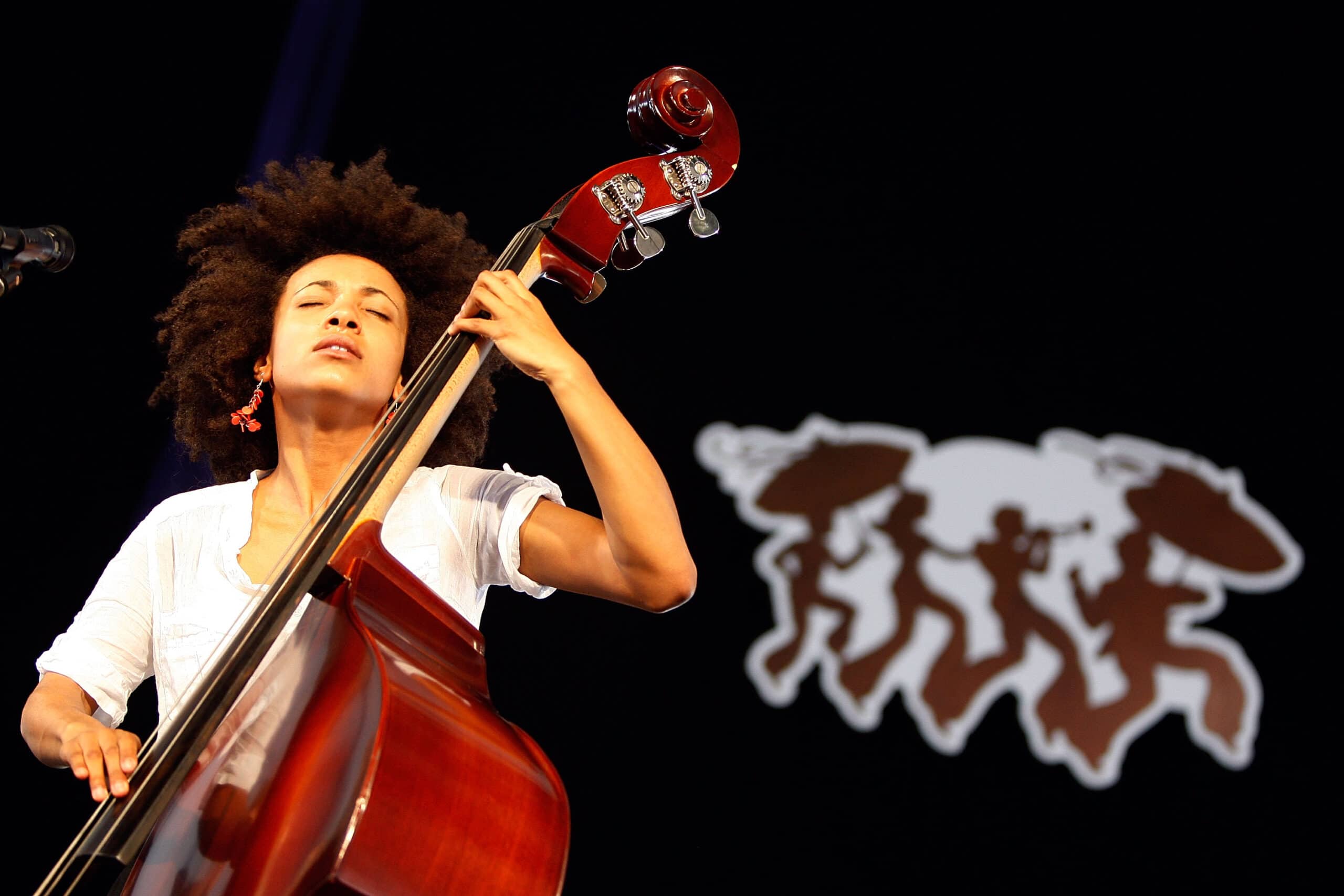
Our appreciation for music can increase as we learn about the people who made it. Music isn’t created in a vacuum, and the history of each song and the people behind it can help us enjoy different types of music more easily.
#10 Henry Mancini

- Life: 1924-1994
- Awards: 40 Wins, 92 Nominations
- Albums Sold: 3.2 Million
- Most Popular Songs: Moon River, The Pink Panther Theme, Breakfast at Tiffany’s, The Days of Wine and Roses
Enrico Nicola Mancini was born on April 16, 1924, in Cleveland, Ohio. He spent most of his childhood in Pennsylvania where he learned to play the flute and piano. He started composing music at the age of 12. He attended a year at Juilliard before being drafted. After serving in WWII, he joined the Glenn Miller-Tex Beneke Orchestra as an arranger and pianist.
From 1952-1958 he arranged over 100 scores for Universal-International Studios. He is credited for injecting jazz music into traditional orchestra film arrangements. He left Universal- international in 1958 and became an independent composer and arranger. He made a career of creating motion picture and television music, as well as recording and concert performances. Some of his most popular film scores include, “Breakfast at Tiffany’s,” “Charade,” The Pink Panther,” and “The Glass Menagerie.”
He performed over 50 concerts per year, which equated to over 600 performances over the span of his career. He also wrote two books. He was awarded four honorary doctorate degrees, UCLA’s Distinguished Artist Circle Award, funded scholarships and fellowships for young musicians, and had a stamp commemorating his lifetime achievements. He passed away in 1994.
#9 Bing Crosby

- Life: 1903–1977
- Awards Won: 19
- Albums Sold: Over 200 Million
- Most Popular Songs: White Christmas, Pennies From Heaven, Straight Down the Middle
Harry Lillis Crosby was born on May 2, 1903, in Tacoma, Washington, and is credited as an “Architect of 20th Century Entertainment.” He is the most successful recording artist of all time, a prolific actor, and a star of radio and television. He left law school just two months shy of graduating to pursue a music career in Los Angeles.
He earned the childhood nickname, “Bing,” from a comic strip he loved. He played drums in Al Rinker’s five-piece dance band and quickly switched to vocals. Bing could learn any song after hearing it only one time. In 1925, he and Rinker set off to Los Angeles to set off on their own.
They initially stayed with Rinker’s sister, Mildred Bailey, who later became a famous jazz singer. She used her connections to land them an audition for a vaudeville show. They were discovered by some musicians in Paul Witman’s band and were under contract with the orchestra within a year of leaving Washington.
Crosby was a member of the very first successful jazz vocal group called the Rhythm Boys. He recorded with Duke Ellington, and Bix Beiderbecke and pretty soon, famous songwriters were writing for him including Johnny Mercer, Jimmy Van Heusen, and Cole Porter.
After his music career took off, he began acting and appearing on television. He signed a 3-picture deal with Paramount Pictures and had a daily show with the CBS Network. He took over The Kraft Music Hall from NBC and created the first broadcast variety show.
During WWII, he was still touring at home and abroad, sold a record number of war bonds, and personally answered thousands of letters from soldiers. He reached his peak success between 1946 and 1948. During this time, he started prerecording his radio show, which NBC took him to court over. He won the lawsuit and switched to ABC. He started experimenting with tape-based recordings which allowed him to edit his studio programs. He introduced canned laughter and applause on these recordings and the entire industry followed his lead.
He started making records and movies well into the 1960s. He started to slow down, mostly appearing on television, and started golfing and going to the race track. Because of his love of the two sports, he built the Del Mar Race Track and created the very first celebrity pro-am golf tournament.
He died on a golf course in Spain on October 14, 1977. He was honored with a moment of silence during the World Series Game that day. Over the span of his career, he released 71 studio albums, and 409 singles, acted in 107 films, and produced nine films.
#8 Billie Holiday
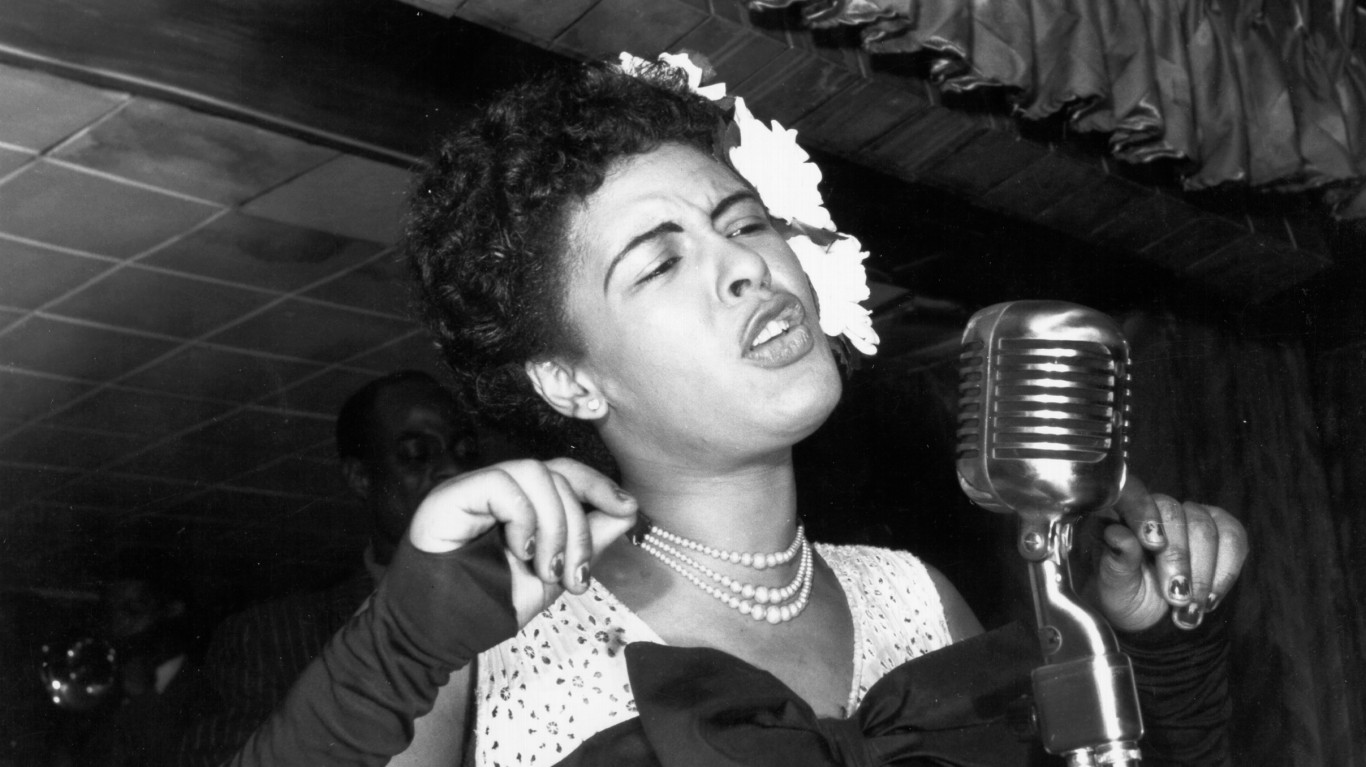
- Life: 1915-1959
- Awards: 9
- Albums Sold: Over 260,000
- Most Popular Songs: What a Little Moonlight Can Do, Easy Living, Strange Fruit, Fine and Mellow
Eleanora Fagan was born on April 7, 1915 in Philadelphia. She is widely considered one of the most influential jazz singers of all time. She spent most of her childhood with her mother in Baltimore. Her father was Clarence Holiday, a successful jazz musician, who wasn’t around while she was growing up. After going to court over her school truancy, she was sent to the House of God Shepherd in 1925 when she was 9. She was returned to her mother later that year after she was sexually assaulted.
She started performing in New York City under the stage name of “Billie Holiday,” in 1930. She was discovered in a Harlem jazz club when she was 18. She began working with Benny Goodman, an up-and-coming clarinetist and bandleader. She sang vocals in several recordings with Goodman, and she moved on to recording with Teddy Wilson and other artists in 1935. She made her first film debut with co-star Duke Ellington later that year.
Holiday started touring with the Count Basie Orchestra in 1937, and in 1938 she became the first Black female vocalist to work with a white orchestra when she joined Artie Shaw and His Orchestra. After racial discrimination against her, she left the orchestra and returned to a solo career.
During this time, she released some of her most famous singles, notably, “Strange Fruit,” which caused a lot of controversy. “Strange Fruit,” is about lynchings in the South and was banned from many radio stations. The controversy made it extremely popular. She was issued a warning in 1939 from the Federal Bureau of Narcotics to never sing, “Strange Fruit,” again. Holiday refused and kept performing the song.
She made an enemy out of the FBN commissioner, Harry Anslinger, who made it his mission to take her down for her drug and alcohol addiction. He relentlessly pursued legal actions against her until her death. Holiday struggled with heroin and opioid abuse since 1944. After her mother died in 1945, her drug use escalated.
She was arrested for drug possession in 1947 and spent one year in jail, which she served in a federal rehabilitation facility in West Virginia. After she was released, she was ineligible to obtain licenses to play in clubs and cabarets. She could still perform at concert halls.
She continued to perform and record until her death in 1959. After her final performance, she was admitted to the hospital for liver and heart issues. She was arrested while in the hospital for heroin use and died from drug-related complications on July 17. She was inducted into the Rock and Roll Hall of Fame in 2000 and had a biopic made about her life in 2021.
#7 Duke Ellington
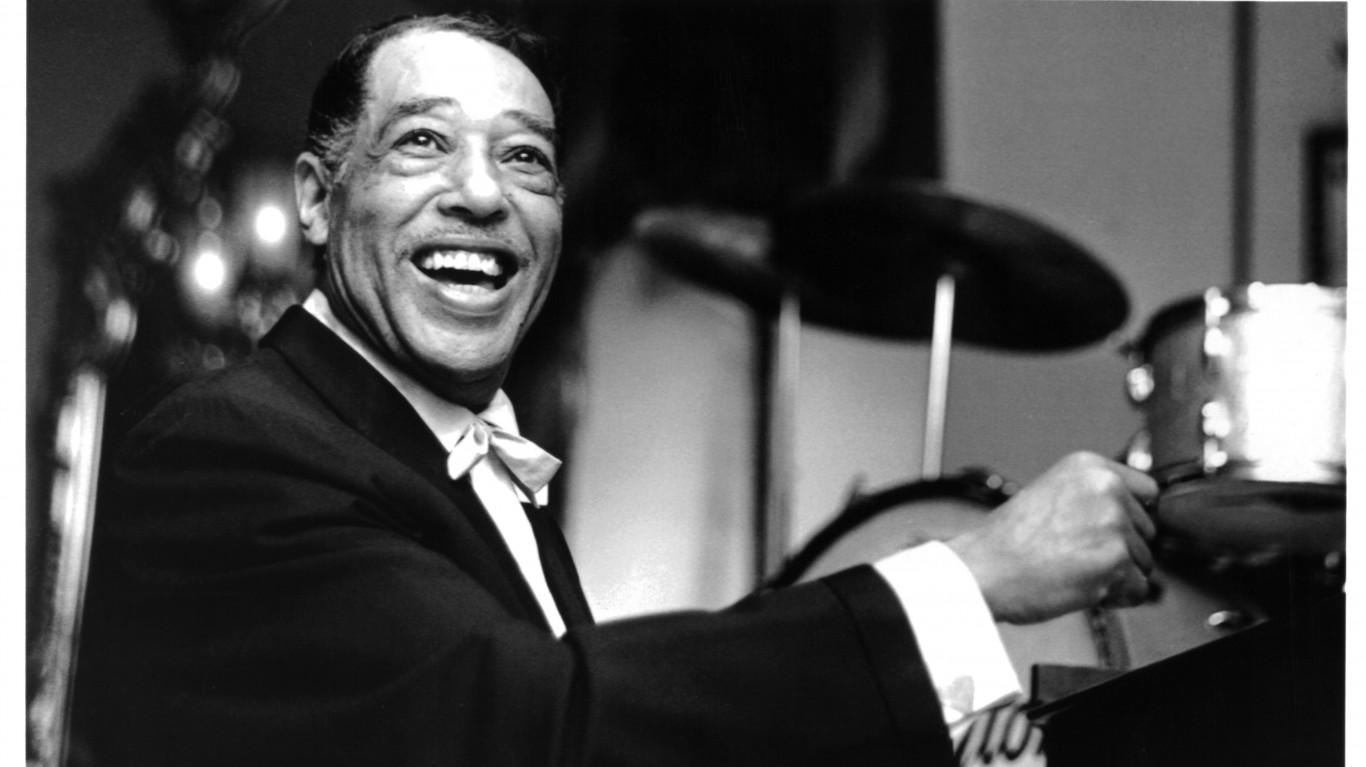
- Life: 1899-1974
- Awards: 12 Grammy Awards
- Most Popular Songs: It Don’t Mean a Thing if It Ain’t Got That Swing, Sophisticated Lady, Solitude, and Take The A Train
Edward Kenndy “Duke” Ellington was born on April 29, 1899, in Washington D.C. His parents were both musically talented and he started playing piano at the age of 7. He wrote his first composition at the age of 15 and turned down an art scholarship to the Pratt Institute to begin playing professionally at the age of 17.
Between 1920–1930, Ellington was a bandleader in several big bands and played at nightclubs, made hundreds of recordings, made several film and radio appearances, and went on two European tours.
His fame peaked in the 1940s when he composed his most popular songs such as “It Don’t Mean a Thing if It Ain’t Got That Swing,” and “Take the A Train.” He was known for creating accessible jazz music and incorporating innovative musicians with unique sounds such as Bubber Miley who made the ”wa-wa,” sound by using a plunger. He earned 9 Grammy Awards while he was alive, and 3 after his death.
He died of lung cancer on May 24, 1974, when he was 75. He was loved and admired by many people, and over 12,000 people attended his funeral.
#6 Sammy Davis, Jr.

- Life: 1925-1990
- Awards: 6
- Most Popular Songs: There is Nothing Like a Dame, Another Spring, Blues in The Night, Happy To Make Your Acquaintance
Sammy Davis, Jr. was born in Harlem on December 8, 1925, to dancer Elvera Davis, and vaudeville star Sammy Davis, Sr. He was a successful singer, comedian, actor, and dancer, and was a member of the Rat Pack. He was a big proponent of the Civil Rights Movement and refused to work with any clubs or venues that practiced racial segregation.
Davis started his performing career by traveling around with his father as a child. He learned to tap dance and he joined his father as a member of the Will Matsin Trio. He was also a multi-instrumentalist, singer, and comedian as a child. He danced in the 1933 short film Rufus Jones for President. He was drafted into WWII and immediately faced extreme racially motivated violence from fellow white soldiers. He transferred to the entertainment regiment and earned a certain level of safety from the attacks. After the war, he rejoined his father’s trio and also started singing in nightclubs and recording albums. In 1947, the trio opened for Frank Sinatra and then toured with Mickey Rooney. Sammy was signed on with Decca in 1954.
In the later part of 1954, he was involved in a car accident that resulted in him losing an eye. He used a glass eye for the rest of his life. In 1955, his first two albums became wildly successful and he soon started headlining in Las Vegas, appeared in movies and TV shows, and starred on Broadway. He was a member of Frank Sinatra’s Rat Pack and performed regularly with his lifelong friend. He was the first artist signed to Frank Sinatra’s record label, Reprise. He had his own televised variety show in 1966 and hosted the show Sammy and Company from 1975–1977.
He was really active in the Civil Rights Movement. He participated in the 1963 March on Washington and is credited for integrating Las Vegas by refusing to perform in segregated venues. He also married May Britt, having an interracial marriage. At the time of their marriage, interracial marriage was illegal in 31 states.
He continued to perform until 1989 when a tumor in his throat was discovered. His last performance was in Lake Taho before undergoing radiation therapy. After a small period of remission, the tumor returned and he passed away on May 16, 1990, at the age of 64.
#5 Ella Fitzgerald
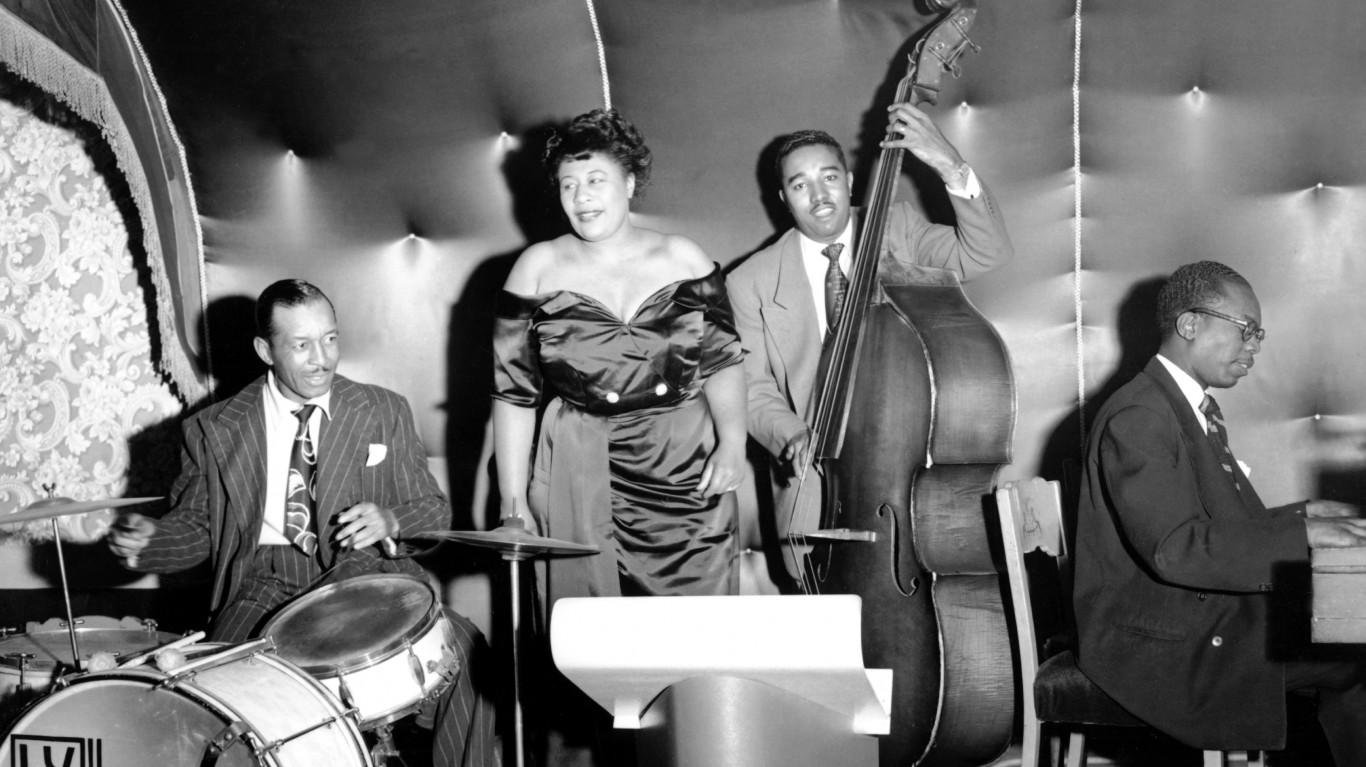
- Life: 1917-1996
- Awards: 13 Grammys
- Albums Sold: Over 40 Million
- Most Popular Songs: (If You Can’t Sing It) You’ll Have to Swing It, Flying Home, Oh, Lady Be Good, Cry Me a River, Dream a Little Dream of Me
Ella Fitzgerlad, “The First Lady of Song,” was the most popular female jazz singer. She was born on April 25, 1917, in Newport News, Virginia. She moved to Yonkers, New York with her mother, “Tempie,” after her parents divorced. Her stepdad, Joe, dug ditches and was a chauffeur. Tempie was a caterer. Her mother died in 1932, followed shortly by her stepfather. Ella and her half-sister, Frances, were taken in by her aunt, Virginia. When she was 15, she fell into a depression and eventually was taken into custody by the police and sent to a reform school, where she was frequently beaten. She escaped the reformatory and set out on her own.
Ella won the opportunity to perform at the Apollo during Amateur Night from a drawing. She intended to dance for her performance but changed her mind last minute. She asked the band to play Hoagy Carmichael’s “Judy,” and by the end of the song, the audience was demanding an encore. Benny Carter was a saxophonist who was part of the band that night, and he began introducing her to his connections.
Through another talent show competition, she won the opportunity to perform with the Tiny Bradshaw band for a week. The Bandleader, Chick Webb, hired her to travel around with them in 1935. By 1936, Ella had made her first recording with Decca. During this time, the trends were shifting away from big swing bands to bebop. She began playing around with the style. She started scat singing and began to master it. She hit fame by 1938 with her rendition of, “A-Tisket, A-Tasket.” It hit number one and stayed on the top pop charts for 17 weeks in a row.
In 1939, after Chick Webb died, she took on the role of bandleader, and the band was renamed “Ella Fitzgerald and Her Famous Band.” In 1946, Ella married bassist Ray Brown. At the time, Ray was working for manager Norman Granz. Granz saw that Ella had the potential to become an international star and signed Ella. While being managed by Granz, Ella joined the Philharmonic tour, collaborated with Louis Armstrong, made TV appearances, and recorded cover songs from 1956-1964.
In 1986, she was diagnosed with diabetes, underwent heart surgery, and had a heart valve replaced. Despite this, she returned to the stage working as hard as ever before. She gave her final concert in 1991 at the Carnegie Hall. When she was 76, diabetes complications required her to have both of her legs amputated below the knee. She never recovered fully from the surgery and wasn’t able to perform after that. She died on June 15, 1996, in Beverly Hills.
Ella frequently donated generously to organizations for disadvantaged youths, and she also took care of her sister’s family after her sister died. She was bestowed several honorary doctorate awards from Dartmouth, Yale, and other universities. She was inducted into the Down Beat magazine Hall of Fame, awarded the Kennedy Center Honors, and was awarded the National Medal of Arts by President Ronald Reagan. She also was awarded the French equivalent, the Commander of Arts and Letters award.
#4 Tony Bennett
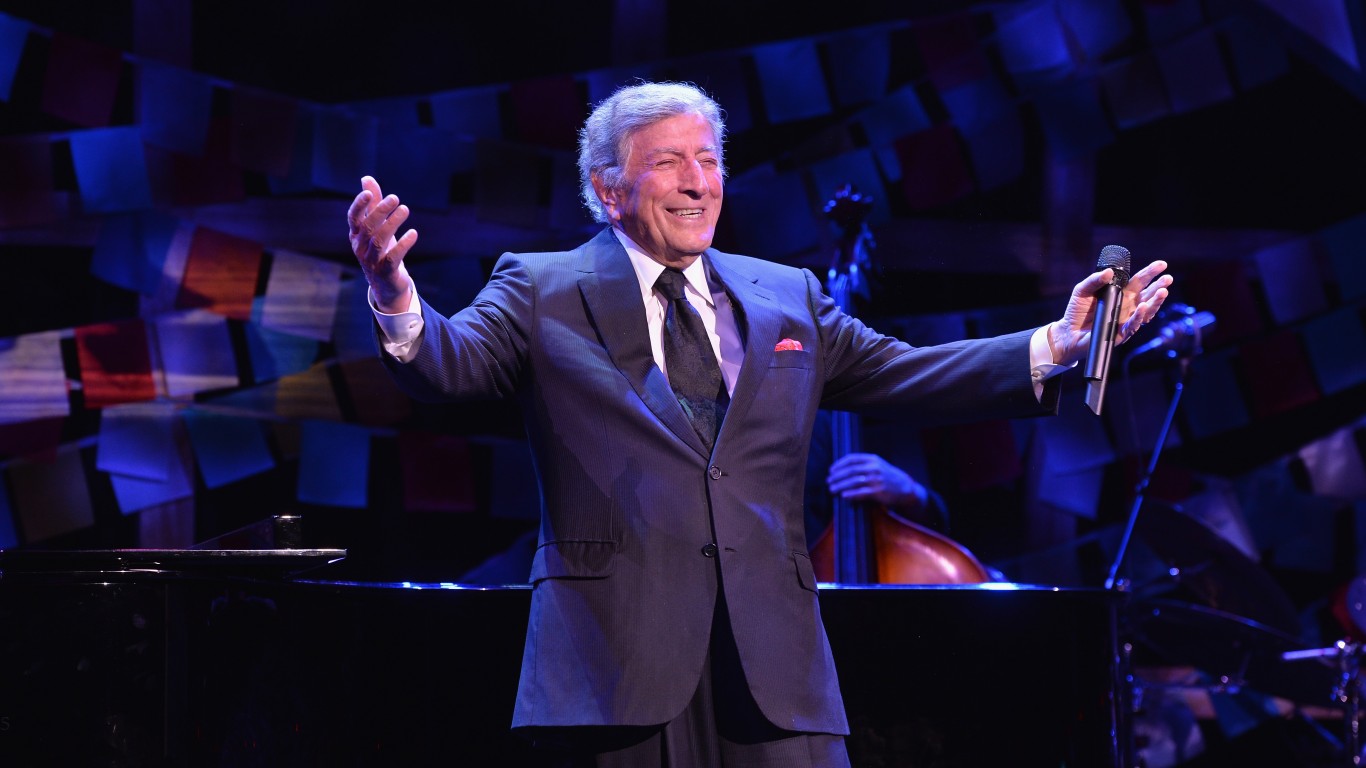
- Life: 1926-2023
- Awards: 20 Grammy Awards
- Number of Albums Sold: 50 Million
- Most Popular Songs: Because of You, Rags To Riches, Stranger In Paradise, The Good Life
Anthony Dominick Benedetto was born on August 3, 1926, in Long Island. His father was a grocer, and his mother was a seamstress, both were Italian immigrants. At the age of 10, Bennett gave a performance at the opening of the Tri-Borough Bridge. He went to the High School of Industrial Arts studying music and painting until he dropped out at 16 to support his family. He worked as a singing waiter in Italian restaurants.
He served in World War II on the frontlines until April 1945. He was involved in liberating the Landsberg, Germany concentration camp. After that, he sang with the Army military band until being discharged in 1946. He then studied at the American Theater Wing on a GI Bill under the Bel Canto singing discipline.
His career started really taking off in 1949 while touring with Bob Hope, under the name of “Tony Bennett.” He signed with Columbia Records in 1950 and reached the #1 spot in the 1951 Pop Charts with his song, “Because of You.” He hosted his own show, The Tony Bennett Show, in 1956 and continued to record jazz music throughout 1962. He recorded, “I Left my Heart in San Fransisco,” his signature song, in 1962.
From 1964–1972, Bennett experienced a decline in popularity which included acting in a major film flop, trying to change his image, and competing with The Beatles. In 1972, he created his own record company, moved to London, and married his second wife. He filed for bankruptcy, and the IRS tried to seize his L.A. home. He suffered from drug addiction and overdosed in 1979. After recovering, his son, Danny, signed as his manager.
He made a comeback by returning to his original tuxedo-songbook style. He signed again with Columbia Records in the 1980s and 1990s and made two golden albums. He received a Grammy Award during this time period and collaborated with Frank Sinatra, Red Hot Chili Peppers, and K.D Lang. He also appeared in TV shows like MTV’s Unplugged and several movies such as Bruce Almighty (2003). He was inducted into the Big Band and Jazz Hall of Fame in 1997 and wrote an autobiography.
#3 Frank Sinatra
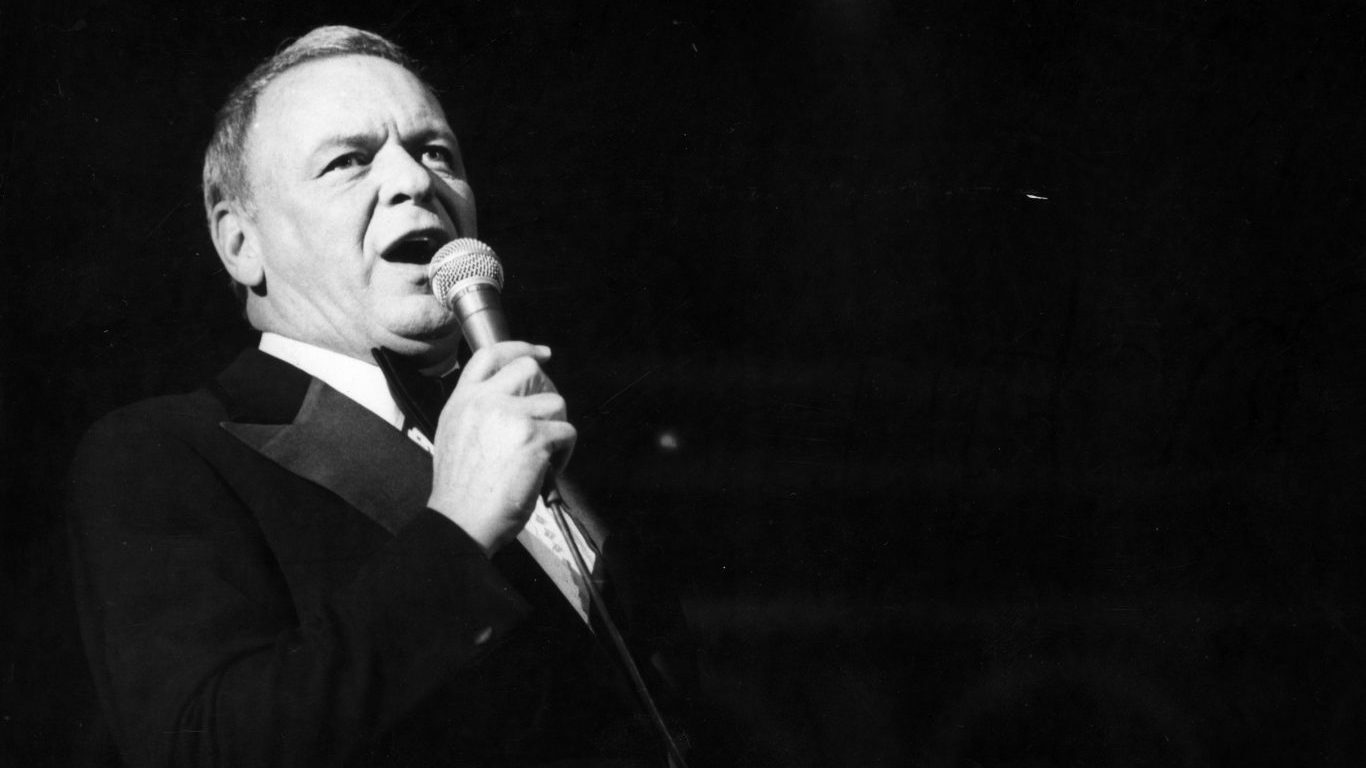
- Life: 1915-1998
- Awards: 13
- Nominations: 15
- Number of Albums Sold: 150 Million
- Most Popular Songs: Fly Me to the Moon, My Way, New York, New York, The Best is Yet to Come
Frank Sinatra was born on December 12, 1915, in Hoboken, New Jersey. His father, Martin, owned a tavern and was a part-time prizefighter. His mother, “Dolly,” was in politics. Sinatra was inspired by Bing Crosby and decided to pursue pop singing. He joined the Hoboken Four in 1935 and won a talent competition with the group on the radio program Major Bowes’ Amateur Hour. They went on a national tour that year, before disbanding. He was discovered in 1939 by trumpeter Harry James, who had recently started his own band.
During his six months with James, he recorded 10 commercial recordings, the most popular of which was All or Nothing. He then joined Tommy Dorsey’s band later that year. He recorded 83 commercial recordings between 1940–1942 with the Tommy Dorsey Band. Wanting to pursue a solo career, Sinatra left the Dorsey band in 1942. By 1943, he was a national sensation. He gained nicknames such as “Frankieboy,” “The Sultan of Swoon,” and “The Voice.”
In 1944, he signed with Columbia Records and recorded dozens of songs until 1953. In 1948, his popularity began to drop due to the press he was receiving about his connections to different organized crime groups, especially his friendships with mob figures Lucky Luciano and Joe Fischetti.
After years of singing over 100 songs per day, he completely lost his voice for several months in 1950 and went into a depression after divorcing his wife, Nancy. He quickly remarried actress Ava Gardner, which further hurt his reputation. Columbia Records didn’t renew his contract in 1952, and he was dropped by his talent agency, and his television show was canceled.
Sinatra was also acting in the 1940s and appeared in films such as Take Me Out To The Ballgame (1949), On the Town (1949), and From Here to Eternity (1953). He made his comeback as an actor and he earned an Oscar in 1953 for Best Supporting Actor. He was regarded as one of the top film stars throughout the 1950s and 1960s. He frequently appeared in films with his close-knit friend group known as “The Rat Pack.” His most popular film was The Manchurian Candidate (1962). He shot his final motion picture in 1980.
He signed with Capitol Records in 1953 and changed his musical style. Over the next nine years, he continued to create music and is credited for creating the “concept album,” and redefining singing into a means of personal expression. During his time at Capital Records, he worked with Billy May, arranger-composer Gordon Jenkins, and arranger Nelson Riddle. His most popular albums of all time were recorded in collaboration with Nelson Riddle. These include In the Wee Small Hours (1955) Only the Lonely (1958), I’ve Got You Under My Skin (1956), and One for My Baby (1958).
In 1960, he founded Reprise Records and recorded there simultaneously while contracted with Capitol Records. He released 14 albums from 1961–1963. His most successful of these is September of My Years (1965) and the song, My Way (1969). He retired briefly from 1971–1973 and then started recording again. He only recorded seven albums between 1973–1994. His final recordings were Duets (1993) and Duets II (1994) where he collaborated with many contemporary pop singers. He retired from films and concentrated on live performances internationally during this era as well. He made over 1,400 recordings over his 50-year career. He died on May 14, 1998 in Los Angeles.
#2 Louis Armstrong

- Life: 1901–1971
- Awards: 2 Grammy Awards
- Number of Albums Sold: Over 3.8 Million
- Most Popular Songs: What a Wonderful World, Hello, Dolly!, Star Dust, La Vie En Rose
Lois Armstrong, aka “Satchmo,” and “Ambassador Satch,” was born on August 4, 1901, in New Orleans, Louisiana. His father, a factory worker, abandoned the family in Armstrong’s first year of life. His mother was a sex worker, and his grandmother took a big part in raising him. He left school in the fifth grade and started working.
In 1912, at 11 years old, Armstrong was arrested for firing a gun into the air during a celebration. He was sent to the Colored Waif’s Home for Boys, where he learned to play the cornet and fell in love with music. He was in the home until he was 14. Beginning to be known as a blues player, he started to be mentored by Joe “King” Oliver, a prolific cornet player.
In 1918, he replaced his mentor in Kid Ory’s band, concentrating full-time on playing cornet. Outside of the band, he played at dances, funeral marches, honky-tonks, and parties. By 1919, he started playing on riverboats with Fate Marable’s band. He learned how to read music, and started befriending other famous jazz players such as Bix Beiderbecke.
He was invited to play in Chicago in 1922 by Joe “King” Oliver and joined his Creole Jazz Band as second cornet. The band recorded an album in 1923, where he recorded his first solo. He married Lillian Hardin, the band’s pianist, in 1924. She convinced him that Oliver was holding him back, and later that year, he joined Fletcher Henderson’s Orchestra in New York City. He introduced swing music to the band and influenced the band to eventually become the first jazz big band. While in New York, he cut several jazz records with multiple artists such as Sidney Bechet, and Bessie Smith.
He made his first album under his own name in 1925 called Louis Armstrong and his Hot Five. He made over 60 records with his band between 1925–1928. These records are known as some of the greatest and most important recordings in jazz history. He also introduced “scat singing” on his records. In 1926, Armstrong switched from the cornet to the trumpet. He kept up his momentum through the 1950s, recording with OKeh Records and Decca Records with The Hot Seven, the All-Stars. He even had roles performing on Broadway and acting in films. He had two songs enshrined in the National Recordings Registry during this time period.
He recorded “What a Wonderful World,” in 1967, which became a No. 1 hit globally. It was used in Robin Williams’ 1986 film, Good Morning, Vietnam. Besides acting and being a musician, he was the first Black jazz musician to write an autobiography. He was also the first Black person to get featured in a major Hollywood movie, Pennies from Heaven. He was the first Black entertainer to host a radio show during his 12-week stint on Fleischmann’s Yeast Show. He continued his career in the 1950s by signing with Columbia Records.
He toured globally throughout the 1950s and 1960s. CBS newsman Edward R. Murrow followed him with a camera crew on some of his tours, which was later turned into a documentary entitled Satchmo the Great in 1957. That same year, he broke his silence on racial issues after watching the Little Rock Nine incident on television. He was quoted as saying, “The way they are treating my people in the South, the government can go to hell.” Which made global front-page news, and made him a significant player in the Civil Rights Movement.
In 1959, he suffered a heart attack in Italy. After taking a few weeks off, he returned to touring, performing 300 nights a year. He recorded the title for the Broadway hit, Hello, Dolly! That was released in 1964 and hit the No. 1 spot on the Billboard Hot 100 by May of that year. He earned a Grammy Award for this album. He continued creating records and touring worldwide until 1968. He started having significant heart and kidney problems and suffered another heart attack in 1971. He continued playing shows until he died in his sleep on July 6, 1971, he was 69 years old.
#1 Nat King Cole
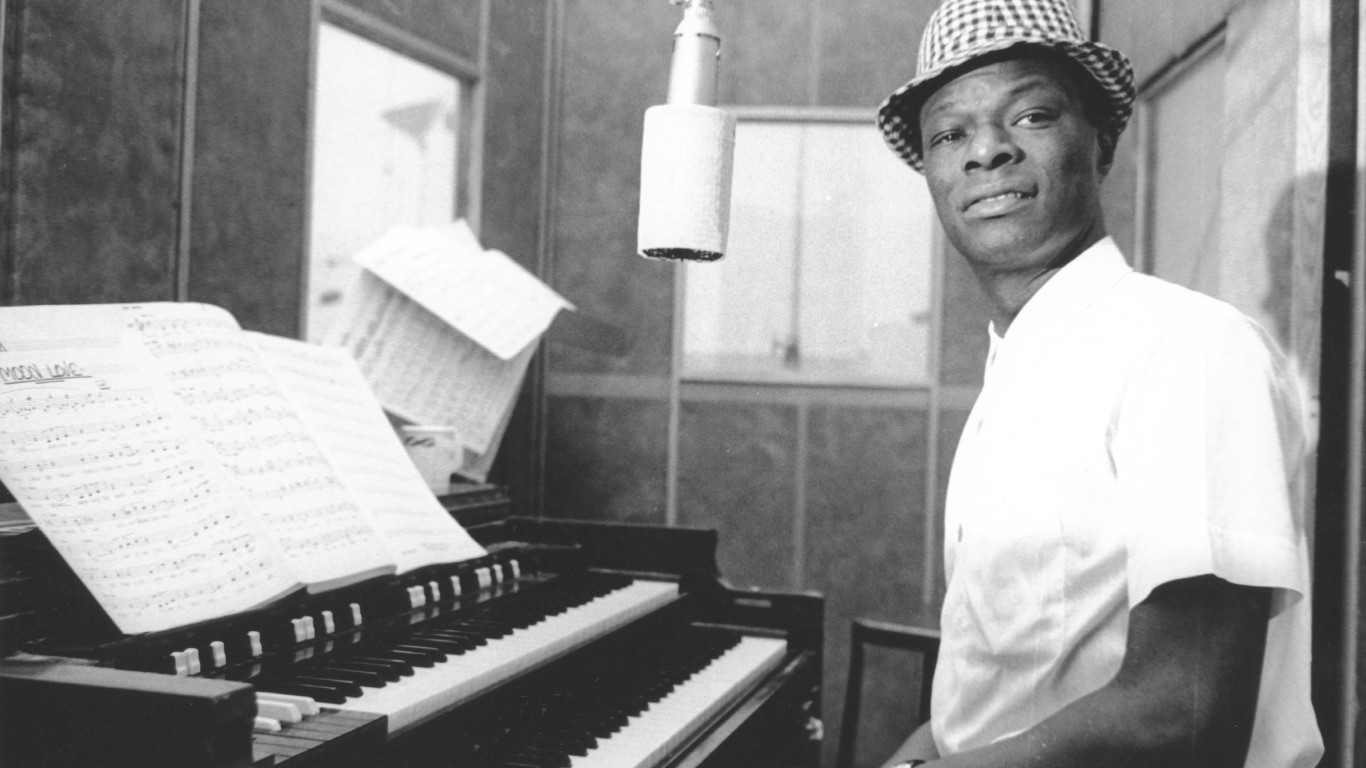
- Life: 1919–1965
- Awards: 28 Gold Record Awards
- Number of Albums Sold: 14.5 Million
- Most Popular Songs: Sweet Loraine, Too Young, Mona Lisa, Ramblin’ Rose, Get Your Kicks On Route 66, Lush Life, L-O-V-E
Nathanial Adams Coles was born on March 17, 1919, in Montgomery. His family moved to Chicago when he was five years old. His father was a minister for the True Light Baptist Church. He received formal classical piano training and started playing church organ by the age of 12, and by 14 he had formed a 14-piece band called the Royal Dukes. He decided he liked Jazz more than classical and dropped out of school at 15 to pursue becoming a jazz pianist full-time. Nat and his brother Cole produced their first professional recordings in 1939.
In 1939 he and his three brothers, Ike, Frankie, and Eddie formed a trio called the King Cole Trio. Some say he gained the nickname, “King,” when his publicist jokingly put a tin-foil crown on his head and proclaimed him to be one, other sources say that he was inspired by the children’s nursery rhyme. The group signed on with Capitol Records in 1943. They gained popularity through 1944 with pop hits like “The Classic Song,” and “Straighten UP and Fly Right.”
In the 1950s, Cole started pursuing a solo career. He often collaborated in the studio with other popular artists such as Louis Armstrong, Frank Sinatra, Nelson Riddle, and Ella Fitzgerald. He topped the charts throughout 1964.
Nat King Cole was the first African-American to ever have his own TV variety show, The Nat King Cole Show ran in 1956. Although it only ran for one season and had no sponsors, it was highly rated and had top-of-the-line production quality. It hosted top celebrity guests such as Frank Sinatra, Sammy Davis Jr., and Harry Belafonte. Even though it was a popular show, sponsors never wanted to pick it up for fear of losing sales in the South.
In the early 50s, Cole moved his family to an upscale, previously all-white neighborhood called Hancock Park in Los Angeles. The community tried to force the family out of the neighborhood through letters and legal action, to no avail. The neighborhood sent the family a letter informing them that “undesirables,” were not welcome in the neighborhood. Cole responded with a letter of his own explaining that if they saw any, “undesirables,” his neighbors would be the first to know.
He was once attacked onstage in Birmingham, Alabama by members of a white supremacist gang called the White Citizens Council, and he sustained back injuries. The group unfortunately still exists today under the name of the Conservative Citizens Council. He sometimes was criticized by Civil Rights Activists for not being involved in the movement enough. He had the opinion that he was an entertainer, not an activist.
He didn’t stop acting after his show went off the air. He often appeared on popular TV shows like The Garry Moore Show and The Ed Sullivan Show. He later moved on to film. His most prominent roles were in films like Istanbul (1957), China Gate (1957), St. Louis Blues (1958), and Cat Ballou (1965).
Cole played a private show for Queen Elizabeth II, earned Stars on the Hollywood Walk of Fame, played in the first Jazz at the Philharmonic, was inducted into the Big Band and Jazz Hall of Fame, performed at the inauguration of John F. Kennedy, and won a posthumous Lifetime Achievement Grammy award.
The Average American Has No Idea How Much Money You Can Make Today (Sponsor)
The last few years made people forget how much banks and CD’s can pay. Meanwhile, interest rates have spiked and many can afford to pay you much more, but most are keeping yields low and hoping you won’t notice.
But there is good news. To win qualified customers, some accounts are paying almost 10x the national average! That’s an incredible way to keep your money safe and earn more at the same time. Our top pick for high yield savings accounts includes other benefits as well. You can earn up to 3.80% with a Checking & Savings Account today Sign up and get up to $300 with direct deposit. No account fees. FDIC Insured.
Click here to see how much more you could be earning on your savings today. It takes just a few minutes to open an account to make your money work for you.
Our top pick for high yield savings accounts includes other benefits as well. You can earn up to 4.00% with a Checking & Savings Account from Sofi. Sign up and get up to $300 with direct deposit. No account fees. FDIC Insured.
Thank you for reading! Have some feedback for us?
Contact the 24/7 Wall St. editorial team.




